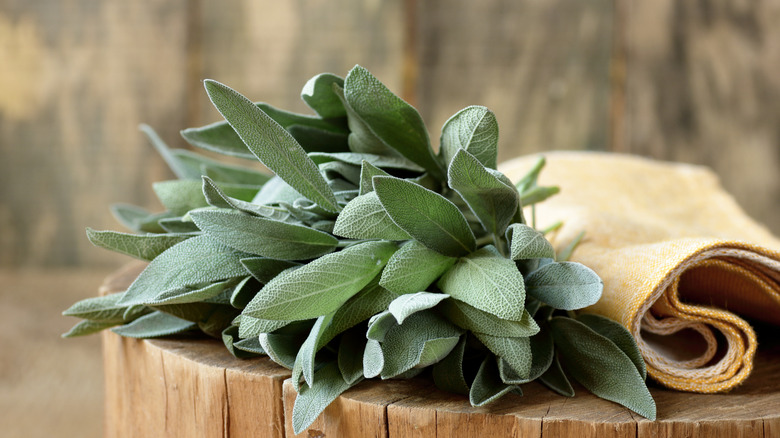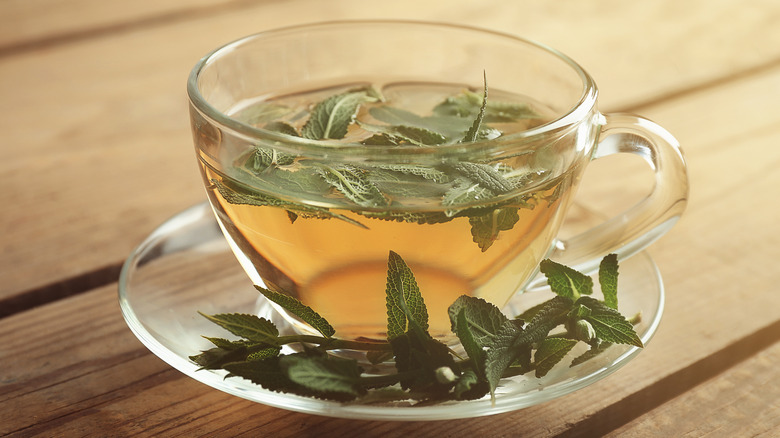What Happens When You Dye Your Hair With Sage?
Searching for home hair dye options can feel overwhelming. You're often left perusing the aisles, reading labels, and wondering if the color will work on your mane or not. There's also the added stress that comes with not knowing which ingredient in there is going to cause damaging side-effects like hair thinning, hair fall, and coarse and brittle hair.
Although there are more natural and organic options out there that claim to have less of a negative effect on the overall health of your hair, not everyone may want to use professional hair dye at home. Also, most permanent hair dyes come with chemicals like ammonia and peroxide that can pose a threat to your hair health (via Style Craze). Finding homemade and/or more natural means to dye your hair is a great way to safely color your tresses as often as you like without the fear of damage.
Sitting strong amidst a list of wonder herbs is the grayish-green tinted sage. This evergreen plant, whose scientific name is Salvia officinalis, can be used as a hair dye, per Hair Buddha, and is often used to cover up grays. Its name originates from the Latin phrase "Salvere" which means "to be saved"; the herb has healing properties that have been enjoyed by Romans and others through history, according to eMedi Health. Here's what happens when you dye your hair with sage.
Hair dye made with sage darkens your locks with time
Dye made using sage may not give you instant or long-lasting results, but the herb offers a safe way to dye your hair whilst also giving you a myriad of other hair benefits, per Leaf TV. All you'll need to make the mixture are a few twigs of fresh sage and 2 cups of water (via Hair Buddha). If you can't find fresh sage leaves, you can use a tablespoon of the dry herb instead. You'll essentially be making a sage tea to use as hair dye.
Once you've placed the sage leaves and water in a pan, wait till it boils, reports eMedi Health. Continue to cook for 5 more minutes at a reduced temperature. Remove the tea from the stove and let it cool for a couple of hours, before straining the blend into a bottle or container of your choice. You can either work the tea into your hair with your fingers and let it air-dry before rinsing or you could apply it to your hair every two nights, wait till it dries, and head to bed, according to Hair La Vie. The pigment can stain your bedding if you don't dry your hair properly.
It typically takes a couple of weeks for the grays to get significant coverage, per Hair Buddha, after which you can reapply every week to preserve the tint. The mixture is particularly effective on darker shades of hair (via Healthline).
Sage hair masks promote overall hair health
Hair dyeing is not all sage is good for. The herb has antioxidant properties that work wonders on your scalp, according to Hair La Vie. What's great about the sage tea mixture is that you can make a big quantity of it and store it to use regularly on your hair for all its added benefits. You can even swap it out with your regular shampoo, reports Hair Buddha.
By preventing dandruff and improving hair texture (via eMedi Health) sage can make your hair look fuller, softer, and healthier. The herb also combats another fear that comes with the constant use of store-bought hair dyes (and aging) — hair loss. Using sage on your hair does a lot for your hair follicles — it stimulates blood supply, unclogs pores, and strengthens hair, all of which contribute to renewed growth and less hair fall.
What really happens to your hair when you dye it using commercial products is no secret. Why not opt to use this herb of Mediterranean origin instead? You can make the mixture right at home, and you can dye your grays with the comforting knowledge that the plant is doing a lot more for your hair.


